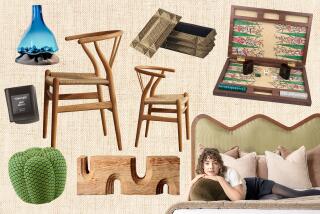Choosing Colors That Will Stay ‘In’
QUESTION: We’re redecorating and want a new color scheme. I know that mauve was “in”--my mother had avocado and gold. I don’t want my home to look dated. How does an interior designer choose colors to avoid this?
ANSWER: The complex influences that affect color palettes range from the political climate to the predominate color selections on a top-rated television series (such as “Miami Vice” pink).
During the 1960s, we experienced the shock of “Aquarius,” Andy Warhol and Peter Max art, miniskirts, civil rights marches, neon and psychedelic. The natural color choices for this era were bright, bold orange, yellow, red, chartreuse and hot pink. The style was Danish Modern, bean-bag chairs and beaded room dividers.
The 1970s brought Kent State, oil embargoes, Watergate, maxi- skirts, and a rise in divorce. So our psyches were depressed and we yearned for security. Naturally, our color choices became heavy and oppressed (no longer the pure brights of the ‘60s). The color palette was brown, avocado green, gold and a burnt, rusty orange. Our yearning for security made us select country or Early American furniture.
So how can you select colors and styles that aren’t dated? By having an awareness of everything that’s going on around you.
Renewed space exploration could bring a rise in popularity of sky blues or patriotic colors. The Olympics in Barcelona may renew our interest in Spanish design and historical colors.
In general, consider the size of your room, its use and the mood you want to create. Warm reds and yellows may seem cheery to some, but they can cause a room to feel smaller or to radiate with tension. Cool blues or greens are calming (they actually slow down the heart beat), and help “expand” a room’s size. Black can be dramatic or mournfully depressing.
SHERRY PAYNE, ASID
(American Society of Interior Designers)
Pasadena
Converting City Furniture to Country
Q: We’ve recently moved to the country and need to have our formal furnishings work for us in this new setting. What can we do?
A: Assuming that you want a “country” look for your new home, I’d recommend that you consider refinishing some of your pieces with a “pickled” or “whitewash” look. Whitewash does not necessarily mean white in color--it’s a wash put on wood that comes in a variety of colored shades.
Painted furniture also works well in a country setting. Depending on the type of furnishings you have, you might consider having your kitchen or den furniture painted and stenciled.
Your upholstered pieces pose no problem as they can be recovered in chintz, plaids or woven textured fabrics. Also there are country wallpapers with small flowered prints and geometrics--many of these have borders and coordinating fabrics.
Redo some of your pictures with more casual framing, add baskets and flowers, and, voila, you have country!
ROEN VISCOVICH, ISID
(International Society of Interior Designers)
Rancho Mirage
Can Homeowner Do Own ‘Sponge Painting’?
Q: I’m fascinated with the kinds of “sponge painting” I’ve seen in magazines and showcase houses. How do I find someone to do this? What does it cost? Or could I do it myself?
A: Sponging, as well as glazing, stippling or blending several shades of color, are all special finishes employed by interior designers. With a little practice and care, you can have the same elegant effect.
Sponging is worked by pouncing a sponge on the wall surface to give it a pebbly texture. The sponging is applied over plain, painted walls and woodwork and then a transparent glaze is added.
There are some excellent books on this subject in your library or bookstore.
There are crafsmen who do this kind of work. The cost of their services might be based on a flat or daily rate, and will vary depending on the size of your project.
Should you find hiring out too expensive or choose not to tackle this type of project yourself, there are wall coverings available that approximate these looks.
SANDRA HAYES, ASID
Orange
Techniques to Light Room That’s Dark
Q: If you have a dark room, what is the most effective lighting?
A: Begin by thinking about the shape and level of light required for tasks you ‘ll perform in this room and for the atmosphere you’d like to create. The direction, intensity and distribution make up the shape.
The shape of light is more important than the fixtures. Often, designers and clients concentrate on the look of fixtures and not on what happens to the light when it illuminates from the fixtures. Light has a dramatic effect on the way a space feels to us.
Shapes of light include beams produced from down lights, adjustable accents and track lights. Washes are created from incandescent, fluorescent or high-intensity discharge wall washers. Pendant or wall mounted up lights, coves, valances and luminous ceilings tend to illuminate a space.
JUDITH J. HASTINGS, ISID
Orange County Chapter


